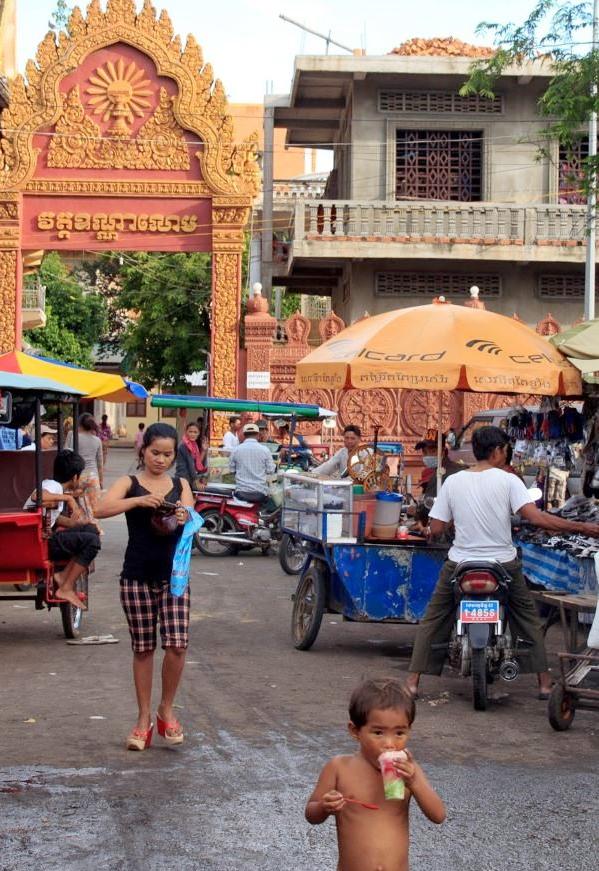
National Economics: Cambodia

Figure 1.--Here we see a The photo was taken at a market in Phnom Penh. Incredibly the Kymer Rouge not only banned markets, they even did away with not only banks, but moneymoney. The idea was to do away with the rich and end poverty. The result was that everyuone was reduced to abject poverty. And in a country with incredibly rich agriculture land, people expereinced hunger and malnutrition. Cambodia still langishes because of the enormous damage done, by the Kymer roug, those that survived were traumitized. The Communist Government that followed, while not a nonsterius regime, pursued economic policies that did little to revive the economy.
|
|
Cambodia astride the Mekong River has some of the richest most productive land in the world. The land is constanly rejuvenated by the silt-rich Mekong. The country was an important rice-culture farming area (first and second millennia BC). The important Kymer Civilization (6th-13th century AD) was based on the prodigious agricultural productivity of the land when supportd by irrigation infrastructure. The Kymers built a complex irrigatiin system (9th century AD). The Kymers and other states in Southeast Asia engaged in trade in the Indian Ocean, exported rice surpluses to counties with rice defecits. The Khmers looked down on commerce. This is one reason that the Chinese or Chinese-Khmers became a dominnt role in trade and commerce. They would become a major target of the Kymer Rouge. The French who colonized Cambodia left the large feudal landholdings largely intact. They developed modern infrastructure, including roads and a railway and introduced new crops, including rubber and corn. With independence, Prince Sihanouk pursued a policy of economic independence and attempted to remain neutral as war enveloped his small country. He managed to obtain aid and investment from different donor countries. North Vietnamese forces entered eastern Cambodia and used it as a safe-haven and as part of the Ho Chi Minh Trail. They began supporting the Kymer Rouge. The war thus spilled over the border and Prince Sihanouk began losing control over large areas of his country. Rice productio suffered, Lon Nol who ousted Sihanouk desired to liberalize the economy, but steadily lost territory to the increasingly well-armed Kymer Rouge. Immediaitely upon winning the civil war (1975), the Kymer Rouge emptied Phnom Penh and the country's other cities. They proceeded to implement their fanatical vision of pure Comminism, essentially murdering anyone with a education--the Cambodian Genocide. They implemented a Four Year Plan, making the rest of the population state slaves working long hours on communes. The result was a decline in rice production and widespread hunger in a country with trendous agricultural potential. The Vietnamese expelled the Kymer Rouge (1978).
The regime put in place a Soviet-style planned economy and a Five Year Plan. The goal was to improve agriculture and promote industry. The slogan was 'export and thrift'. The reult as in Vietnam was widespread poverty. The collapse of the Soviet Union and the bject fau=ilure of Comminist ecomomics forced the Government to adopt some market reforms. Political insatbility has impeded ecoomic progress. Cambodia is tiday a mixed evomomy based largely on agriculture. Industrial development is minimal.
CIH

Navigate the Children in History Website:
[Return to the Main Cambodian page]
[Return to the Main Asian economics page]
[Return to the Main economics country page]
[Return to the Main Economics page]
[Introduction]
[Animals]
[Biographies]
[Chronology]
[Climatology]
[Clothing]
[Disease and Health]
[Economics]
[Ethnicity]
[Geography]
[History]
[Human Nature]
[Law]
[Nationalism]
[Presidents]
[Religion]
[Royalty]
[Science]
[Social Class]
[Bibliographies]
[Contributions]
[FAQs]
[Glossaries]
[Images]
[Links]
[Registration]
[Tools]
[Children in History Home]
Created: 1:45 PM 2/18/2015
Last updated: 1:45 PM 2/18/2015



